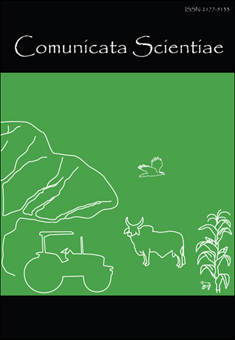OPTIMIZING INDUCED MUTATION TECHNIQUE FOR THE IMPROVEMENT OF AGRONOMIC TRAITS IN PIGEON PEA [Cajanus cajan (L.) Millsp.] LANDRACES
DOI:
https://doi.org/10.14295/cs.v5i3.430Keywords:
Induced mutation, M1 mutant, improvement, stability, pigeon peaAbstract
Creation of variability through induced mutation is cardinal in genotype selection. However, the stability of the mutants in the subsequent generations is of utmost importance for improvement and commercialization. This current research was aimed at evaluating the performance of pigeon pea landraces following amiprophos methyl (APM) treatment and thereafter assesses the stability of the M1 mutants. Thirty seeds each of two varieties of pigeon pea (brown “Fiofio”, white “Fiofio”) were soaked in 0, 4, 6 and 8 ppm amiprophos methyl (APM) for 48 hours. After the first growing season (2010/2011), mutant seeds were harvested and replanted in the next growing season (2011/2012). The result from the parental generation showed that the brown “Fiofio” variety grew taller (270.44cm), produced more branches plant-1 (17.31), had broader leaf area plant-1 (83.37cm2) and increased petiole length plant-1 (6.83cm) while the white “Fiofio” produced more leaves plant-1 (~310). Additionally, the germination percentage (~98 days) increased including the days to 50% flowering (183 days) for the brown variety while days to 50% maturity increased for white variety (~198 days). Plants raised from the M1 mutant seeds of white “Fiofio” variety produced more pods plant-1 (~157 pods) and had increase seed yield plant-1 (777 seeds) with increased weight of 100-seeds (17.32g). However, plants raised from brown “Fiofio” produced more number of leaves plant-1 (~2716), had taller plants (230.6cm) with increased days to 50% flowering and maturity (184; 176 days, respectively). It was observed that there was stability of traits that were hitherto positively affected by 4 ppm APM treatment such as increased number of leaves (2568), number of flowers (494), number of pods (192) and seed yield plant-1 (946). Explicitly, there were obvious positive significant effects of APM treatment on pigeon pea, especially at 4 ppm. The improved traits were further stabilized in the M1 generation. Most of the genetic estimates of morphological traits were high and wide, especially the broad sense heritabilities. PCVs were higher than GCVs encouraging phenotypic selection of traits. The implication is that selection can be made on these traits for further trials.
Downloads
Downloads
Published
How to Cite
Issue
Section
License
All articles published may be reproduced or utilized in any form or by any means whether specified Comunicata Scientiae, author(s), volume, pages and year. The authors are responsible for all the statements and concepts contained in the article.




